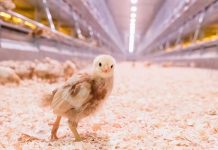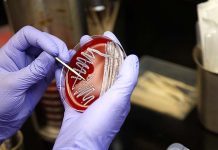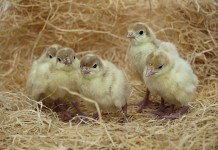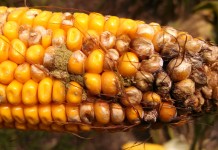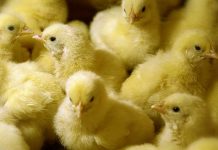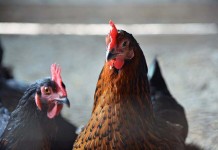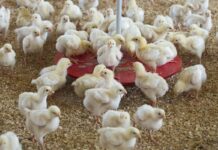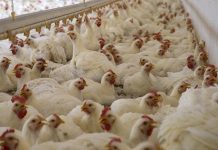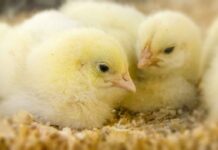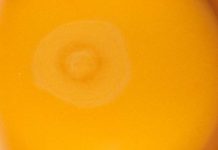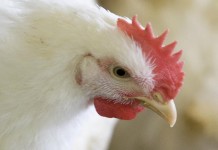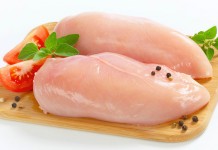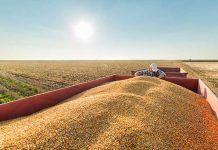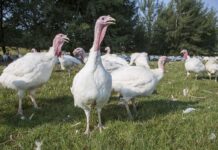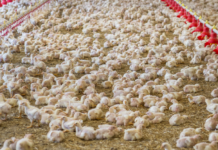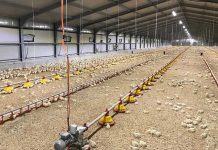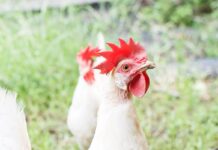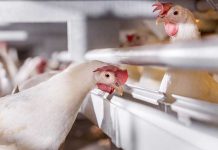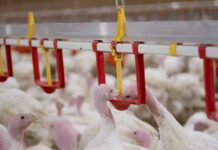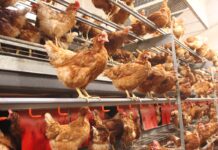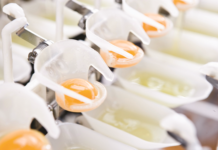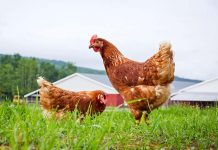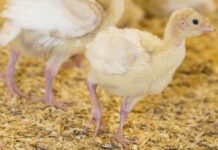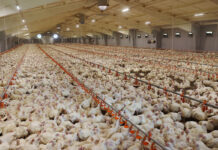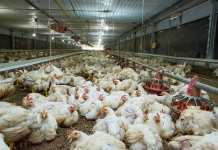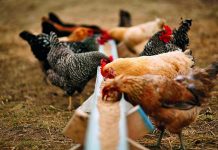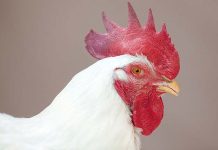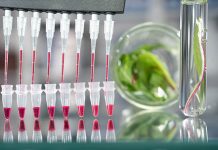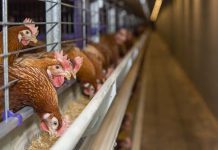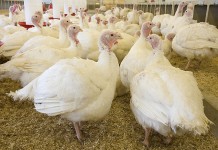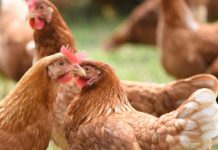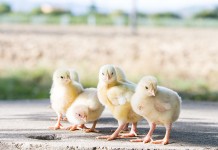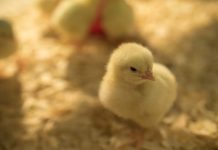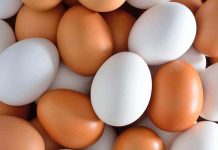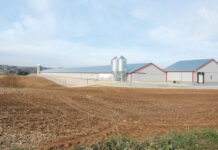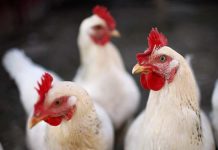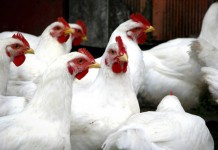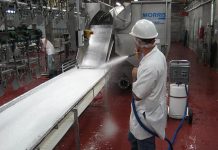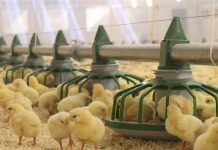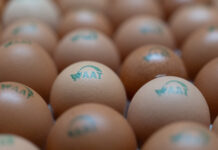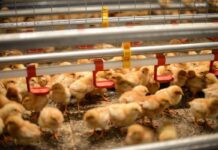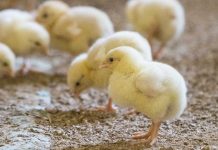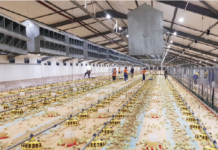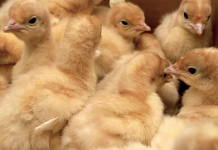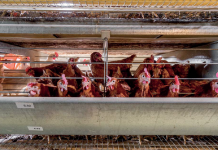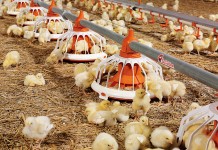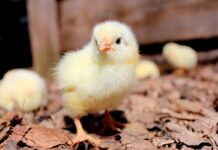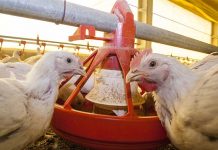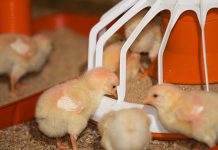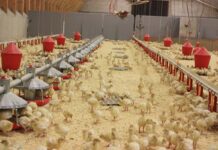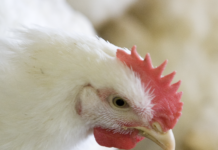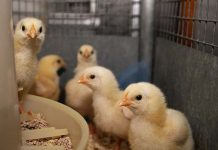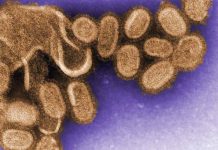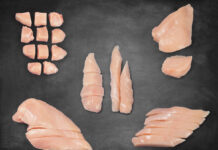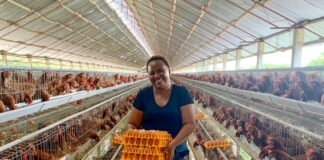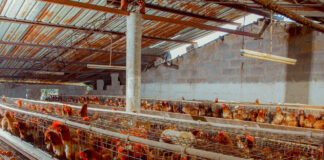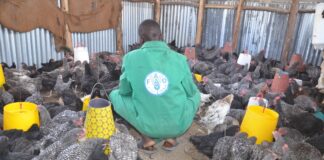Alternative housing system’s impact on feeding pullets and layers
In order to satisfy consumer demands for their food to be produced a more “humane” manner the retail outlets are pushing the egg industry...
Investigating diseases affecting poultry production
Severe diseases such as highly pathogenic avian influenza and velogenic Newcastle disease are still a concern for poultry producers and government agencies alike. Companies...
Effective ventilation key to Cobb500™ development
Effective ventilation plays a key role in the health and performance of broiler flocks. Nigel Strain, Cobb senior regional technical manager for Europe, the...
Researchers characterize selected variant Avian Reovirus strains
USPOULTRY and the USPOULTRY Foundation announce the completion of a funded research project at the University of California, Davis, in which researchers looked to...
Testing day-old poults
When poults are received at a farm from the hatchery they should be good quality poults; namely, free from physical defects, actively looking for...
Feed borne mycotoxins: the threat to poultry?
Mycotoxins are metabolites produced by molds (fungi) that can infest crops pre-harvest and can continue to flourish under sub-optimal storage conditions. Grains with high...
Considerations for a better quality of chicks
During the incubation period, embryonic growth and development are affected by different factors, as breeder age, the incubation temperature and the availability of egg...
A more sustainable poultry production
Researchers must find other approaches to food production and processing - and in particular for poultry production - using new technologies in conjunction with...
Transgenerational impact of broiler breeder nutrition
Continuous genetic selection in meat-type chicken for rapid growth resulted in increased meat production and decreased the time required for achieving the market weight....
The future of probiotics
USPOULTRY and the USPOULTRY Foundation announce the completion of a funded research project at the Western University of Health Sciences in Pomona, Calif., in...
The effect of hot and cold hatcher temperature profiles on hatchability and chick quality
An eggshell temperature of 100°F (37.8°C) is widely accepted as optimal for embryonic development from the start of incubation up until transfer time. Eggshell...
Fertile or not?
Fertilisation and a fertile egg marks the beginning of a new life but is by no means a guarantee of a long life, as...
Broilers perform better with intermittent lighting programs
Roles of certain parts of the digestive tract of chickens seems to have been lost with the evolution of time and commercial practices. Gizzards...
Water holding capacity in poultry breast meat
Water holding capacity (WHC) is defined as the ability of meat to hold its inherent and added moisture during fabrication, processing, and storage.
EU Compound feed production in 2021 – Market Outlook 2022
Industrial compound feed production in the EU remained stable in 2021. Looking forward, the spread of animal diseases and the continuing global grain market...
Corn milling efficiency and particle size effects on pullet growth performance
Corn is usually ground locally at the feed mill, while soybean meal is pre-processed and feed mills have little control over its particle size...
Effects of feed presentation on growth performance and gut health of turkeys
The combined effect of feed presentation parameters bears considerable implications for the digestive health and growth performance of turkeys. This topic is very relevant...
Algae products in organic poultry diets
Algae, “the not so new kid on the block” has been used in both human and animal diets dating back centuries. There is a...
Fear in turkeys, implications for productivity and wellbeing
From an evolutionary standpoint, fear is an adaptive response that promotes survival by enabling animals to avoid injury and death. Because of the important impact that fear has on animal well-being, fear has formed the basis of many scientific studies and is included as part of welfare assessment programs such as the Welfare Quality Assessment Protocol for poultry.
Biosecurity in poultry farming: an effective tool to fight infectious diseases
This is the first of a series of technical articles on biosecurity in poultry farming produced within the European project “NetPoulSafe - Networking European...
Pellet quality and its effects on poultry performance
Pellet quality provided to meat birds throughout the industry is highly variable. Feeding birds pellets of poor quality can in part be attributed to...
Poultry study points to genes linked to food bug
Variation in the response of poultry to Campylobacter helps identify key genes that may provide resistance to infection.
Research has identified genes in poultry that...
Biosecurity measures and new vaccines to combat the spread of bird flu
The recent H5N6 bird flu outbreak is confined to the south of England, partly due to the introduction of an Avian Influenza Protection Zone...
Turkey breeder health, new welfare challenges and demands
The health of turkey breeders is critical to ensure the economic production of high quality fertile hatching eggs to produce poults which can be raised without antibiotics.
Reducing the environmental impact of egg production via breeding and alternative diet
Egg production has an important role in the global production of food. For decades, we have successfully selected laying hens that efficiently produce animal...
Researchers investigate the characteristics of Turkey Hepatitis Reovirus
USPOULTRY and the USPOULTRY Foundation announced the completion of a funded research project at the University of Minnesota in which researchers investigated the characteristics of Turkey...
Perches: environmental enrichment or mechanical challenge?
The study compared the impact of wire ramps and perches on meat chicken mobility and the incidence of detached femoral caps (DFC), which can...
Outdoor broilers behavioural time budgets
The demand for free-range chicken meat is increasing. Free-range products are usually perceived as more welfare friendly by consumers and particularly fulfil the belief that the ability to perform natural behaviour leads to better welfare.
Understanding egg quality
Egg quality is multi-faceted, with physical, functional, and microbial aspects contributing to egg quality. Research has shown that many factors impact egg quality including...
Efficacy and economics of oral fluralaner for the treatment of northern fowl mites in...
Once mites are observed in one area of the barn they tend to progressively spread to the whole barn and subsequently to the next...
Researchers examine the role of APEC in turkey cellulitis
USPOULTRY and the USPOULTRY Foundation announce the completion of a funded research project at the University of Georgia in Athens, Georgia, in which researchers...
Biological control of Salmonella in the poultry industry: a European perspective
Salmonella remains one of the most important foodborne bacterial pathogens worldwide, and is frequently linked with the consumption of contaminated poultry meat and eggs....
Practical views on global poultry nutrition – Second part
The demand for poultry meat will increase because of population growth and changing socio- economic factors. Resources will become constrained and changing consumer perceptions...
Performance benefits of probiotic and protease in broilers subject to Eimeria challenge
Consumer pressure and government regulations are driving US poultry industry to remove antibiotic growth promoter (AGP) from poultry production.
Nutrition program including feed additives is...
Insights into hunger will aid poultry welfare
Brain processes controlling hunger in birds and poultry are to be examined, to better understand how stress experienced during development in the egg impacts...
Cobb suggesting management tips to maximize male fertility
The role of males in poultry breeding is extremely important. Each male is responsible for fertilizing 10 or more females. Each hen produces at...
Alternatives to antibiotics in organic poultry
Organic poultry production is one of the fastest growing segments of organic agriculture with a 20% average annual increase since the establishment of the...
Vitamin D in laying hens: how high is high enough?
In 2010, the Institute of Medicine in the United States reviewed current literature and changed the estimated average requirement of 400 IU/day to a...
Managing coccidiosis in birds raised without antibiotics
For poultry producers to make a profit they must have healthy, uniform sized birds, make sure there are no real or assumed human health...
Bacterial bile salt hydrolase for a good microbiota
However, limiting antibiotics use could compromise animal production efficiency and health. Thus, there is an urgent need to develop effective alternatives to antibiotic growth...
Turkey breeding – Where from, Where to? – Domestication of animals was a major...
All species of today’s domestic plants and animals followed an analogous pattern of multi-generational change influenced by humans. The modern populations of turkeys followed...
Influenza antibodies made by Pirbright reduce disease in chickens
Scientists at The Pirbright Institute have engineered synthetic antibody
molecules that can be administered to poultry to reduce the symptoms of Influenza, as well as...
A new poultry research center at the University of Bristol
A state-of-the art poultry research centre offering specialist, industry-focused research into both laying hen and broiler health, welfare, behavior and productivity has recently been...
Early introduction of whole-grain diets to broiler chickens
The main problem with introducing whole-grain diets (WGD) to newly hatched chicks is the kernel size and this has led to such diets being...
A new perspective on feeding broiler breeders
Due to sophisticated genetic selection programs carried out by poultry breeding companies such as Aviagen, today’s broilers can grow with very efficient feed conversion...
Measuring egg shell quality
Maintaining egg shell quality is important for maximizing production of broiler chicks from breeders as shell quality and hatchability go hand in hand. Thin...
Limiting embryonic overheating during incubation
Embryonic overheating can represent an issue for incubators. For many things in life, a change in temperature of +0.5°C is hardly noticeable. However, for...
Balancing beetles with the bottom line
Darkling beetles, commonly referred to as litter beetles, are a widely encountered pest for those in the broiler production industry. Litter beetles are holometabolous...
Biosecurity practices and investments implemented by today’s poultry producers
One brick higher
The 2015 outbreak of highly pathogenic avian influenza (HPAI) virus devastated the United States poultry industry. A novel Eurasian-North American H5N2 was...
Separating welfare facts from fiction
It has become a confusing market for customers to decipher which technologies offer the best welfare-friendly solutions for their animals. How do you separate...
On free amino acids – Their role in starch and protein digestive dynamics
The quantity of glucose and amino acids absorbed from the small intestine is a function of dietary concentrations, feed intakes and digestibility coefficients. Moreover,...
Requirement of digestible calcium at different dietary concentrations of digestible phosphorus for broiler growers
An experiment was conducted to determine the digestible calcium (Ca) and digestible phosphorus (P) requirements of 11-24 days old broiler chickens.
L.S. David1, M.R. Abdollahi1,...
Research assessed peracetic acid in poultry processing wastewater treatment systems
USPOULTRY and the USPOULTRY Foundation announce the completion of a funded research project at the Georgia Institute of Technology in Atlanta, Georgia, in which...
Lowering dietary calcium and available phosphorus in broilers
The aim of this trial was to investigate the effect of lowering dietary calcium (Ca) and available phosphorus (av.P) during Starter (0 to 10d),...
From challenge to breakthrough: embryo sex determination with Cheggy technology
Efficiency and innovation are shaping the future of the egg industry. In modern egg production, every step, every resource - and every animal - counts....
The role of early experience on the behavior of hens housed in cage-free aviaries
Understanding the consequences of rearing experiences on the behavior and bone integrity of laying hens can help inform solutions to animal welfare and management...
Better hatch and post-hatch performance
Hatchability, chick quality and post-hatch performance improve substantially when embryo-response parameters are actively controlled during incubation. The BioStreamerTM concept, developed by Petersime, continually monitors...
General overview and installation of light traps in broiler breeder rearing
Designing a ventilation system for a dark out tunnel ventilated rearing house can be challenging. There are many different models and designs of light...
Poultry litter quality: investigating the interrelationship between litter moisture content, pH, water activity and...
Wet litter is a recognized issue in commercial poultry production and litter quality has come under great scrutiny with the introduction of farming scheme...
Re-stored turkey eggs outperform untreated eggs stored for 8 to 15 days by 7%
By using heat treatment during storage up to 14 days, as part of your standard hatchery practice, it is possible to gain up to...
Impact of investment in Hendrix Genetics’ breeding and testing program
With the upcoming release of the new performance standards for Hendrix Genetics’ laying hens, it is important to examine factors contributing to the genetic...
10 alerting signs of poor ventilation
Proper ventilation is basic in poultry farming as it reduces mortality, stimulates early feed intake, improves flock uniformity, and ensures an adequate temperature regulation.
Here...
Prevention of cross-contamination in the hatchery
How to properly prevent cross-contamination in the hatchery. Here some easy steps to achieve a better biosecurity in your hatchery.
World Veterinary Day – celebrating the value of vaccination
The theme of this year’s World Veterinary Day – celebrated April, 27th – was Value of Vaccination. To celebrate it, some of the vaccinology...
Flexible Feed Formulation with GALLIPRO
Facing challenging goals
The goal of the poultry industry is to provide consumers with safe food, while promoting poultry health and welfare, in addition to carefully...
A review of novel biological alternatives to antibiotic therapies in poultry
As poultry producers in Australia continue to limit antibiotic use, increasing numbers of alternative therapies and chemical biosecurity products are being used to overcome...
Dietary energy, digestible lysine and available phosphorus levels influence growth performance and carcass traits...
Energy (E) and amino acids (AA) are two of the most expensive components in broiler diets. There is no general consensus regarding the interaction...
Dekalb White hens to be first occupants of innovative layer house
Environmentally friendly farm with lots of innovations
Four Dutch entrepreneurs are set to build an innovative new layer house in the south region of The...
The effects of a multi-enzyme and Bacillus probiotic combinations on calcium and phosphorus digestibility...
450 day-old male Ross 308 chicks were randomly allocated to 3 dietary treatments with 6 replicate pens per treatment and 25 birds per pen....
Animal breeding reduces environmental impacts
Results of a study show that breeding reduces environmental impacts of animal products by about 1% per year. This is achieved without specific selection...
Increased cecal butyrate concentrations protect against Salmonella Enteritidis
Butyrate is a molecule that is extensively studied as a feed additive to improve gut health and animal performance. It also has been described...
Challenges in poultry feeding
Poultry producers around the world continue to struggle with high production costs for poultry feeding, largely due to volatility in prices for basic feed...
First week management of turkey poults
In commercial turkey production we aim to replicate and improve on what a mother turkey supplies to her young in the wild, this include...
A dose response of a heat stable phytase on broiler performance and nutrient digestibility
Phytases have been heavily researched for decades and been used commercially since the early 1990s. Phytase from microbial origin is therefore added to monogastric...
Crude soybean lecithin and vegetable acid oil as energy sources for broiler chickens
Lecithin and acid oil, as co-products from vegetable oil refining process, are economic alternatives to conventional fat sources and may represent an efficient energy...
Sample management and handling for diagnostic testing
Diagnostic testing is an important and widely used tool in commercial poultry husbandry. A key to best use of diagnostic testing, is to begin...
H7N9 flu mutation identified that allows immune system escape
The research, published in the Journal of Virology, demonstrated that small genetic differences in the virus surface proteins can prevent antibodies that protect against...
The effects of diet and epigenetic alterations on the gut microbiome, inflammation and poultry...
The gut microbiota is a fundamental force influencing diverse aspects of avian physiology. Microbiome studies are at a critical juncture and facing a challenging...
Improving poultry products safety
The research is part of the Association’s comprehensive research program encompassing all phases of poultry and egg production and processing.
Dr. Hong Zhuang at...
Six questions about high-volume chicken fillet portioning
Modern technology and software bring an infinite number of cutting options.
The huge volumes of chicken fillet needed to satisfy global demand go way beyond...


